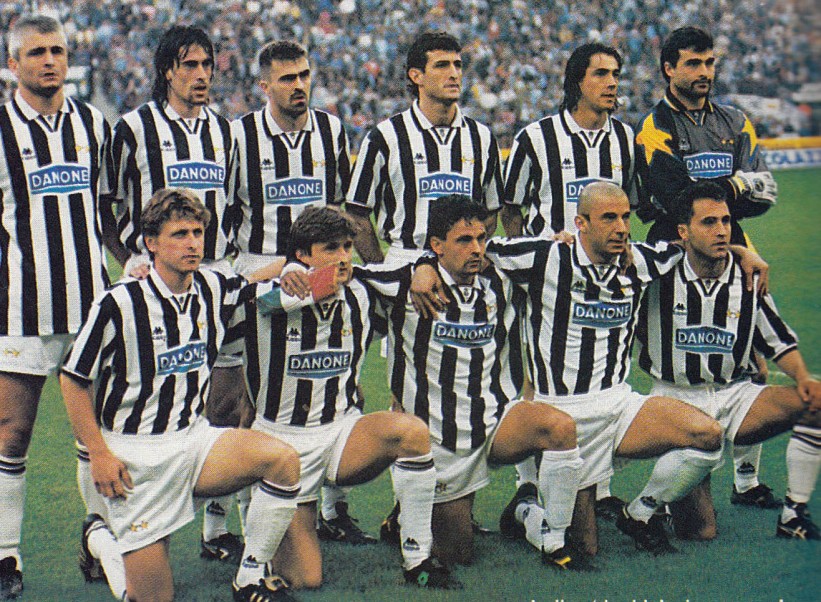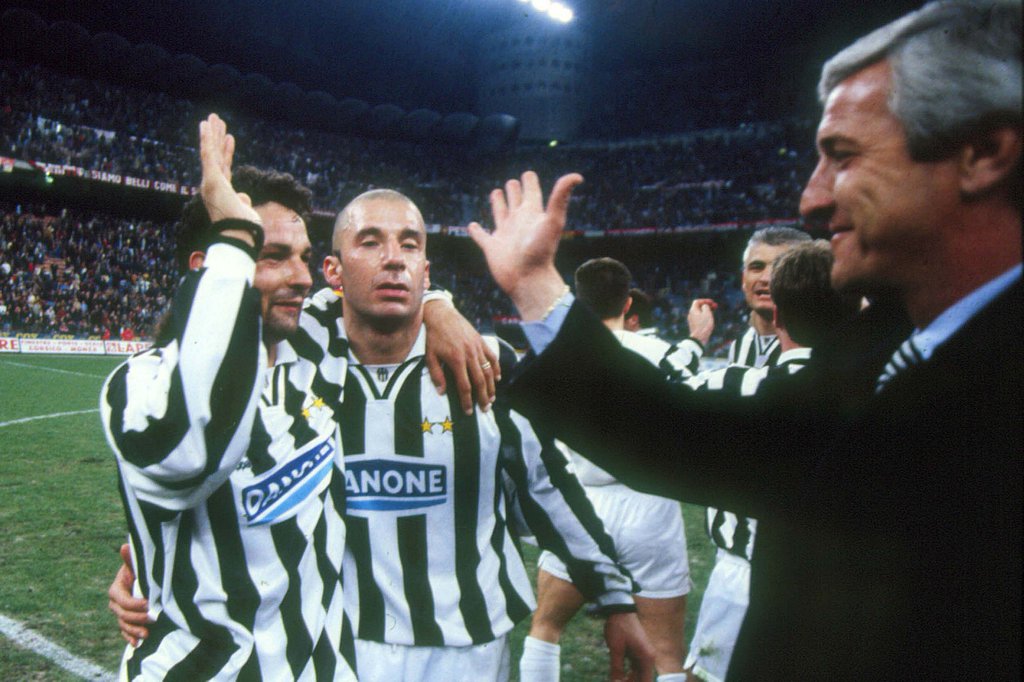You’ve seen it so many times down the years, the same picture that’s always trotted out, regular as clockwork. Whenever there’s a discussion about the greatest club sides of all time, in that list, somewhere, will invariably be the Juventus team of the mid ‘90s. The picture is of course the one taken before the start of the Champions League final against Ajax, on a stuffy, Roman Wednesday evening in May 1996.
The photo, it must be argued, is indeed a magnificent one: the Juve players looking resplendent – regal almost – sporting the club’s finest blue and yellow effort, complete with scudetto and Coppa Italia badges. A ruggedly handsome Alex Del Piero kneeling front and centre, surrounded by the shiny dome of Gianluca Vialli, the granite-chiseled features of Pietro Vierchowod, the white feather Fabrizio Ravanelli, and the ageing rockstar looks of Antonio Conte and Moreno Torricelli. It’s enough to get the eyes misty.
Many see this photo as the visual apex of Lippi’s first era; the greatest iteration of his constantly evolving sides during that five-year, trophy-laden spell. There is a great deal of logic in that train of thought; they would beat Ajax – narrowly it must be said – to become European champions before defeating a strong River Plate to win the Intercontinental Cup in Tokyo later in the year. 1996 was the year of The Old Lady.
Others look towards the 1997/98 team, mainly due to the majestic presence of one Zinedine Zidane, who was beginning to show Jack Walker that he was just a tad better than Tim Sherwood. It also contained a peak Del Piero and an emerging-but-not-quite-there-yet goal-poacher supreme Pippo Inzaghi. Not to mention the Dutch pitbull Edgar Davids, a masterful mid-season signing. However, they’re always viewed through the prism of the Mark Iuliano-bulldozing-Ronaldo-in-the-penalty-box incident, and the club’s second consecutive Champions League final defeat to Real Madrid despite going into the match as overwhelming favourites.
Going back to the 95/96 team, it’s worth bearing in mind that they failed to retain their league title, finishing second to Fabio Capello’s Milan, and it wasn’t a closely run title race; Juve were closer to finishing seventh than catching the champions. Their retention of the Coppa Italia failed to live past October, knocked out by eventual finalists Atalanta. Even during their victorious Champions League run, they lost three times en route to the final. By comparison, the 1996/97 side, arguably the weakest and least fondly remembered of the first Lippi reign, remained unbeaten until the final.
The best – and certainly the most underappreciated on a wider scale– was the 1994/95 double-winning side. Lippi’s first season produced the slickest football – and contained the highest calibre of players – of not just his first spell, but also his second. This was a squad not only brimming with heavyweight talent, but also with heavyweight leaders; a collection of captains in every area of the field: from Angelo Peruzzi in goal, and a backline of hardmen in the shape of Ciro Ferrara and Jorgen Kohler; to Didier Deschamps and Antonio Conte in midfield, and Gianluca Vialli and Roberto Baggio in attack.
Lippi quickly implemented a 4-3-3 system, with Del Piero and Ravanelli flanking Vialli through the middle. Upon taking over in the summer of 1994, Lippi vowed to make Juve less ‘Baggio-dependent’. This was shrewd strategy from Lippi as under previous boss Giovanni Trapattoni, giving the ball to Baggio was plan A, B and C, there was no alternative. Lippi, fairly quickly, recognized that if Juventus were to knock Milan from their frightening perch, this had to change.
Lippi’s desire to make Juve unpredictable was made easier by the Divine Ponytail’s long absence, missing five months of the season through an injured knee sustained in a match against Padova. When Baggio returned in the spring, Lippi switched to a 4-3-1-2 in order to accommodate him for the title run in. Lippi found himself in a position where he had a wildcard in the world’s best player – as peculiar as that might sound – in so far that opposing teams wouldn’t know what formation Lippi would use from one match to the next. Lippi had a tactical versatility that he would never be afforded again.

From left, standing: F. Ravanelli, M. Torricelli, S. Porrini, C. Ferrara, P. Sousa, A. Peruzzi; kneeling: G. Marocchi, R. Jarni, R. Baggio (captain), G. Vialli, A. Di Livio.
The midfield trio was a cohesive unit that possessed everything. Vialli told Scottish journalist Graham Hunter that in Sousa, Deschamps and Conte, they had “brain, heart, legs and skills.” Sousa, in particular, was so good that he was voted Juve’s player of the season. If Deschamps and Conte were the hearts and legs, Sousa embodied the brains and skill. An unknown quantity in his first season, the midfielder made such an impact in 1994/95 that in his second season, his form dipped due to opposition managers assigning players to specifically man-mark him.
It also represented the career peak of Ravanelli and a return to form for Vialli, both of whom thrived under Lippi’s coaching. Vialli, especially, had come under great scrutiny to deliver after two years of relative mediocrity. The player who flourished at Sampdoria during their glory years hadn’t been seen in Turin since his £12m signing in the summer of 1992. Vialli scored 17 league goals in 1994/95, more than in the two prior campaigns, combined.
Ravanelli, by contrast, blossomed into one of the most fearsome strikers in Italy after being a bit-part player under Trapattoni. His relentless work ethic and razor-sharp left foot saw him score five goals in a UEFA Cup tie against CSKA Sofia, a record that was only equaled by Aritz Aduriz for Athletic Bilbao in 2016. It was this season that saw him gave birth to his trademark shirt over the head celebration in a game against Napoli at the San Paolo. He plundered 30 goals in all competitions, a feat he would only achieve once more – his single season with Middlesbrough.
Both, like Sousa, wouldn’t reach the same levels in the Champions League-winning season. Nor was the squad up to the standard of the double-winning side. The departures of Robert Jarni, Kohler and Baggio, especially, weren’t adequately replaced, and as a consequence, the 1995/96 side was a little less spectacular, and a little more vulnerable, than many remember them to be.
Lippi – like all Italian managers of the period – based his fundamentals on every player working together to form a unified, structurally sound unit. Whilst this ethos was ingrained into every Lippi side, he wasn’t a coach for individuals, there was a certain element of freedom to the 1994/95 side, and this manifested itself in the form of some swashbuckling displays. The highlight of which was the day they ended their nine-year wait for the title against Parma.
The two clubs battled not only for domestic supremacy, but also for European bragging rights, facing off in the finals of the Coppa Italia and the UEFA Cup, whilst going toe to toe in the league. They met six times over the course of 1994/95, five times in May and June alone.
Buoyed by losing the UEFA Cup just days before, Juventus promptly tore their would-be challengers to shreds at the Stadio delle Alpi, winning 4 – 0. Baggio, who was back to his 1993 Ballon d’Or-winning best in the final two months of the season, produced a monstrous display, laying on three assists for Deschamps, Vialli and Ravanelli. While the Parma side of 1999 are the darlings of nostalgic social media types, the 1995 team were equally as strong, with Messrs Zola, Asprilla, Sensini, Apolloni and Baggio (Dino) in their pomp.
It’s oft-forgotten that Juve were 180 minutes away from doing the first Italian treble, some fifteen years before Jose Mourinho’s Inter. Younger readers might sneer at the UEFA Cup now, but for much of its original lifespan it was viewed as the strongest UEFA trophy. It reflected the true strength of one’s league, and winning it was a valued objective and not the long, mostly tedious distraction it morphed into in the 21st century. In 12 games they only lost once, at the Ennio Tardini in the first leg of the final.
To further demonstrate the depth of leadership, nine members of the 1994/95 squad later became managers, with Conte, Deschamps, Sousa and Carrera all winning leagues in various countries. Vialli won the Cup Winners’ Cup and several domestic cups with Chelsea, while Deschamps also led France to the final of Euro 2016 and Monaco to the Champions League final in 2004.
While the Champions League-winning side is cherished by Juve fans – and it is solely because of that – they simply weren’t as good as the double-winning outfit. They scored less, conceded more, and lacked the individual brilliance, tactical variation and fluidity that finally dethroned Milan from the pinnacle of the Italian game the year before. It’s rather odd firing off numerous deficiencies about a side that conquered Europe and later the world, yet it doesn’t make it any less true. History, as it tends to do, has airbrushed their weaknesses.
More needs to be done in recognising the undue brilliance of the side that ended Juve’s scudetto drought. There was enormous pressure on Lippi to succeed; Milan (x4), Inter, Napoli (x2) and Sampdoria had all won during their barren spell. Even serial winner Trapattoni, at that point not a man accustomed to failure, couldn’t do so, finishing runner-up twice. So if you’ve made it this far, raise your glass to the class of ’95, Marcello Lippi’s greatest side.
Words by Emmet Gates: @Emmet Gates
Emmet is a freelance football writer based in Italy. He is the author of Goal O’The Times and as well as The Gentleman Ultra, he has written for FourFourTwo, These Football Times and In Bed With Maradona.

